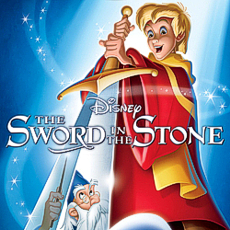Walt Disney Productions (December 25 1963), Walt Disney Studios Home Entertainment (August 6 2013), Blu-ray plus DVD, 79 mins plus supplements, 1080p high-definition 1.75:1 widescreen, DTS-HD Master Audio 5.1, Rated G, Retail: $36.99
Storyboard:
A young King Arthur to be has to learn the ways of the world from bonkers old wizard Merlin before he can assume his rightful place on the throne.
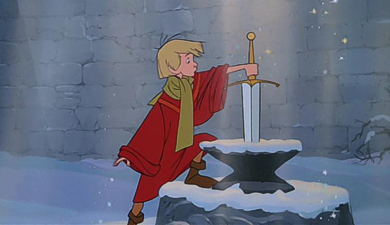
The Sweatbox Review:
First released in 1963, Walt Disney’s take on the young King Arthur tale, The Sword In The Stone, falls into late-period Walt, when the Studio had to make its animated films without the intense supervision the old Moustro had shown to the early classics Snow White, Pinocchio, Fantasia and Bambi. By the early 1960s, Walt’s preoccupation with Disneyland (both the park and the weekly television show that shared the same name), big live-action features such as Mary Poppins, the EPCOT park project, and not to mention growing concerns with his health, meant that he spent less and less time in the animation department, which was becoming an expensive operation to run. “You know,” he once said jokingly to his animators, “with live action I can go out with the actors and film a scene in a day. You guys take six months!” Although this was true, Walt was always good to his artists and chose to cut costs in the animation division rather than scrap the very department that had built the company entirely. These cost-cutting methods primarily came in the form of the Xerox process of copying the animators’ drawings directly to cels, cutting the amount ink and paint staff previously needed considerably. The result shows the lines of the artists’ pencils much more clearly and lent a new sense of “life” to characters, although Walt took some time to warm to the different look of his productions.
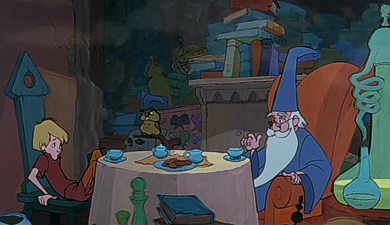
Primarily developed for One Hundred And One Dalmatians to aid the depiction of hundreds of spotty dogs, the Studio did produce some classic films in this period and artistic format. Dalmatians introduced the sketchier technique and this was a good choice of story to begin the new Disney style with, as its contemporary feel was well suited to the rough edged animation approach and the angular, block-colored backgrounds created for the film. The Xerox process also contributed heavily to the free-wheeling, loose feel of The Jungle Book (making the animals really feel hairy), while the look also helped give the Winnie The Pooh films a defined “illustration come to life” style – something that the computer aided systems of today have great trouble in replicating. Somewhere in the middle of all of this was The Sword In The Stone, an often underrated Disney picture that is all too seldom seen and usually released to home video as part of a package of titles that get lost under the weight of whichever lead title the Studio is pushing at the time; a process that has seemingly been skipped this time so that it can arrive in HD with a duo of comparable titles (Robin Hood and Oliver And Company).
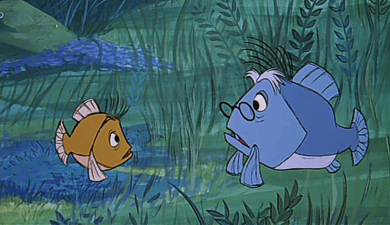
Based on the 1938 novel by T.H. White (Walt Disney actually bought the rights a year later, but it took him some 20-odd years to translate the story to screen), The Sword In The Stone recounts the tale of a young King Arthur back when he was a mere squire in training, and nicknamed Wart. He is destined for greatness, something only the wizard Merlin is aware of, and must be taught the ways of right and wrong before taking his place in history. Through a number of magical transformations, Merlin changes Wart into a fish, a squirrel and a bird in order to learn about the things that make the world go round (though parents needn’t worry – there are no bees involved)! Slowly Wart begins to understand that his otherwise downtrodden life has a purpose, and after he survives an encounter with the mad Madam Mim and finally makes it to the jousting match where he will make a name for himself, he is ready to fulfil his destiny as the only one who might be able to pluck the title sword from its stone.
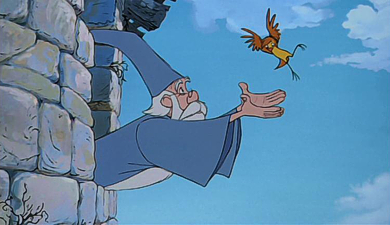
Perhaps one of the main reasons why The Sword In The Stone does fail to slot into the “classic” features made by Walt Disney is precisely because of its rough animation style. While Sleeping Beauty was created with the lush storybook-come-to-life feel that audiences had come to expect from a Disney film, it was still the box-office failure that led to the cost cutting in the animation department. The new Xerox process fit the groovy 60s Dalmatians like a glove, but here the story certainly calls for a recall of that fairy-tale quality, with its themes of royalty and magic. Given the rougher style of design, the screenwriters went with a more comically enhanced script, and so the otherwise awesome Merlin becomes a blundering nitwit wizard, and Mim never rises to being a true villainess. In fact, the story doesn’t actually have a central villain at all, apart from the slight danger in Wart’s own situations, and so there is no central arc or final incentive for protagonist or antagonist to aspire to. As a result, it’s easy to see how the Studio got into the rut of their next few films being very episodic in structure.
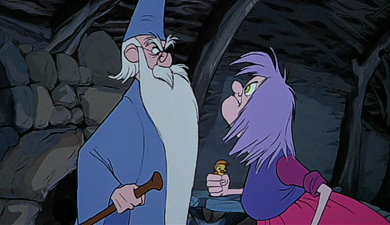
There is no real thread that runs through The Sword In The Stone, as the story wanders from encounter to encounter, ultimately ending up at the title’s stone, from which the sword must be drawn. It comes very late into the movie, by which time the audience may well wonder why the film has been given its name at all. When it does finally come, the moment is portrayed very well, although again it seems that writers were stumped at how to top such a momentous occasion with any kind of climax, as the film winds up within minutes of this happening, with another handful of jokey remarks. One could say that the whole point of the film is exactly this: that all of Wart’s lessons has been provided to him in order to arrive at this end, to become the man he must be to lead the kingdom, and once this event has transpired, what would be added by any extra running time? However, the lessons brought forward for Wart to learn do not seem to result in anything; the poor boy is never given the chance to do anything with the knowledge he has acquired. Even in the celebrated Wizard’s Duel, a clip that has been seen countless times in Disney compilation specials, Wart stands by helpless while Merlin steps in to save him from Mim.

The Sword In The Stone was the first Disney picture that owed all of its directorial vision to one man: Wolfgang “Woolie” Reitherman, who would continue to fashion the Studio’s animated output well after Walt’s death in 1966. As such, perhaps the team spirit that helped gel the previous Disney outings failed to materialize, with each part of the Studio carrying work out on their own particular section of the film independently. The few songs, by the Sherman Brothers, are, except for Mad Madam Mim, rarely included in any soundtrack compilation sets, although they all have a bouncy rhythm and Higitus Figitus uses the word play that helped establish the Shermans at the Studio and led to the Supercalifragilisticexpialidocious tongue twisters of Mary Poppins and United Artists’ Chitty Chitty Bang Bang. The rest of the soundtrack is the usual mixture of American and English voices that always seems to work in animation, and each compliment their roles nicely.
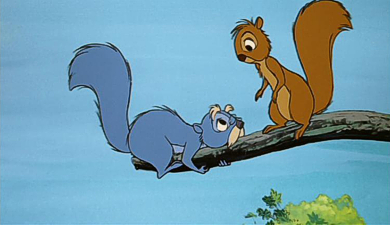
Disney fans can have a field day listening out for the many talents involved as many of them were either veterans or future voices for other characters: Wart (Rickie Sorenson) was part-voiced by Wolfgang’s sons Richard and Robert (who also contributed to Winnie The Pooh and The Jungle Book); Archimedes, Merlin’s talking owl, was Junius Matthews, later to become Rabbit in the Pooh films, while Sir Ector was vocalized by Sebastian Cabot, also doubling as the narrator, another future Pooh performer (again as the story-teller) and as Bagheera in The Jungle Book. The story lends itself well to the Disney treatment (by Bill Peet), with its themes of magic and wizardry, and there are many memorable moments, but as a whole it just seems to lack the classic touch. Animation wise, it is fine and the backgrounds display good detail and continuity, although there is some recycling of material from Sleeping Beauty, both visually and musically, but given the irreverent tone, this is possibly an in-joke (the ending also bears a similarity with 1992’s Aladdin, when Merlin returns from the future clad in a loud Hawaiian shirt).

One does wonder what direction the film would have taken if it had been animated in the 40s or 50s, when Walt first bought the rights and was in the middle of perfecting the animated art form, but in any event The Sword In The Stone does stand up as a fairly faithful translation of White’s book and, Dumbo aside, could be described as the first of the Studio’s more broader knockabout comedies of which the later The Jungle Book would share a little of before the style was brought back in the Studio’s later films such as the aforementioned Aladdin, Hercules and, perhaps, most flippantly, the also recently released to Blu-ray The Emperor’s New Groove. If nothing else, The Sword In The Stone stands as a classic example of Walt having fun with an otherwise academic subject, while also teaching us some lessons along the way. Although even I couldn’t say it was first-rate Disney, there is still an abundance of magic here.
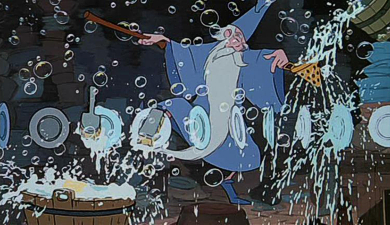
Is This Thing Loaded?
I’m not too sure if I appreciate Disney’s current trend of releasing as many of their films on the high-definition Blu-ray format as quickly as they can as a good thing or a bad thing. Sure, it means our shelves can get pretty stacked up sooner than later with the Studio’s classical animated features (by my count, we’re soon to only require the 40s Package Features and some 1990s titles to more or less have complete collections). But it also means that these BD updates don’t always get the full attention they should, the in-house producers of these discs – if, indeed, they are actually being overseen by any one person – choosing to essentially base these new releases on the last available DVD edition rather than start from scratch and award each title the respect they deserve, complete with archival materials that would retain all previous extras and bring something new to the titles for long-time fans.
Fortunately, not all three of Disney’s August 6 titles (Stone, Robin Hood and Oliver And Co.) suffer from this same syndrome – that is, the dropping of more than a few bonus features from line-ups that were never that stacked to begin with – and, Oliver apart, there’s a small return to earlier titles that chose to include at least one small new supplement as an added treat. Here it’s a Never Before Seen Alternate Opening where Wart meets Merlin in a slightly different way instead of falling into the Wizard’s cottage, and in which Mim has more of a presence. With animated storyboards presented (unlike the rest of the standard definition extras) in HD, this four minute sequence makes for a nice added touch and peek into the Disney story process.

Although The Sword In The Stone has never really been seen as one of Walt’s truly classic endeavors (mainly due to the reasons highlighted above; even its LaserDisc debut skipped on offering anything of note), Disney actually gave the film a surprisingly fine DVD treatment for its Gold Collection series, with some fascinating extras including a full edition of the television show Walt Disney Presents. Unfortunately, although this disc retains most of the other supplements, it bases itself on a later 45th anniversary edition, which means all we get here is Walt’s introduction from All About Magic (1957), in which Disney looked at magical traditions, handing over to Magic Mirror Hans Conreid for a mix of clips and original material, with some nice animation touches and a lot more of Walt that we usually get in the television specials, although we lose all that with just the opening scenes, running around seven minutes.
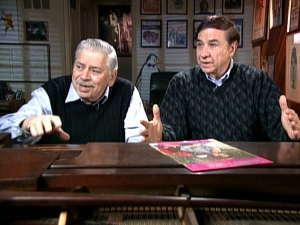
Also from previous discs, the brothers Sherman appear in the retrospective interview documentary, Music Magic: The Sherman Brothers, in which Richard and the late Robert explain their involvement in The Sword In The Stone, their first animated picture, and how they came to write the songs for the movie. Running eight minutes, this is a lovely piece, similar to their accounts of working on Bedknobs And Broomsticks from that film’s DVD, and featuring some wonderful concept art, storyboard sequences and, best of all, the brothers playing through a couple of songs from the movie, including two deleted songs, Old Oak Tree and The Magic Key, from earlier abandoned versions. Real magic!
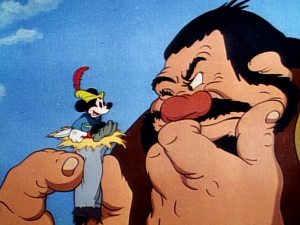
A couple of animated Bonus Shorts are again carried over from the Gold and 45th anniversary editions. A Knight For A Day is a favorite Goofy cartoon of mine, and compliments the main feature well with its modern spin on the jousting matches of old. The link between the feature and the excellent 1938 Mickey Mouse cartoon The Brave Little Tailor seems to be only that it is set in olden times, although it is one of the great cartoons, with some of the best animation of Mickey in the 30s, and was rewarded with an Oscar nomination for Best Short. Mickey’s short looks the better of the two here, but it’s unfortunate that the BD uses the same old composite video transfers as before, lacking the remastering that was carried out for their Disney Treasures releases or even bothering with nice new HD upgrades in a missed opportunity.
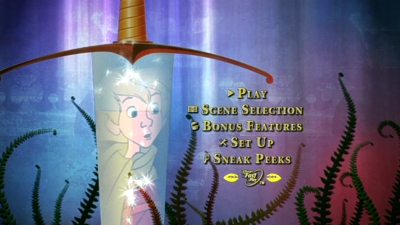
Lastly, a Disney Song Selection merely runs through the song sequences from the film with sing-along subtitles, while the enclosed DVD is essentially the 45th anniversary edition, and although a reprint of the Gold Collection disc would have been neat for the Walt-hosted TV episode, at least this features updated previews and Sneak Peeks which, across both discs, include The Little Mermaid, Planes, The Lion King musical on stage, The Muppet Movie, Return To Never-Land and The Many Adventures Of Winnie The Pooh among others. Best of all, it retains some extra extras, including a 61-image Sword In The Stone Scrapbook of production artwork, a selection of Film Facts trivia, and an otherwise useless Merlin’s Magical Academy game.
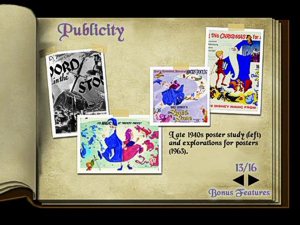
Case Study:
Although it only plays as almost an afterthought in the movie, the moment when Wart draws the titular sword from its stone has been the main focus on each and every one of Disney’s home video releases of the film since the VHS days, so it’s no surprise to see yet another angle of the same scene again here. Nicely lit and featuring a subtle Merlin in the sword’s reflection that might go missed at a first quick glance, it’s a slightly different approach to what we’ve seen before, presenting a rather striking and dramatic image, more in keeping with Stone’s original DVD release than the awful 45th anniversary cover. The rest isn’t too exciting: inserts are restricted to Rewards code and Movie Club promos, and the back sports a questionable “before and after” shot of the digital restoration, although this new batch of August Disney titles at least give us a listing of their discs’ contents, even if there’s still no mention of the aspect ratio!
Ink And Paint:
There’s been a lot of wondering about how The Sword And The Stone should and would be presented on Blu-ray…and the lack of aspect ratio tech spec on the back of the sleeve won’t help anyone make an informed purchase! The bottom line is this: after the epic widescreen approaches of Lady And The Tramp and Sleeping Beauty (which replaced the Academy framing of every film from Snow White to Peter Pan) in the 1950s, Disney animation had to take a budget cut in terms of overall production spending. The Xerox process came into effect for One Hundred And One Dalmatians, which came as presentation trends shifted towards a general widescreen process, sometimes confused with VistaVision, which took a regular 1.37:1 frame and masked top and bottom to give the now standard 1.85:1 aspect ratio we still see today.
With the then-1.33:1 television screens a major force in how a move would be seen after its initial theatrical showings, many producers opted to shoot their films to a “protected” 1.37 Academy frame, allowing theaters to mask the top and bottom for a widescreen presentation (protected in the framing so as to not crop heads or important image information) and television screens to “open matte” the masking so that picture would not be cropped from the left and right of the image (more cumbersome to reframe for even with the dreaded pan-and-scan process). The basic truth is that Walt did the same with his animated features, framing for theatrical widescreen and leaving space top and bottom for later TV showings on his anthology TV show, long before home video and HD were ever dreamed of.

So, while it could be argued that both versions (an intended theatrical widescreen ratio and the original negative aspect) were valid and could be included, as I have indeed insisted upon in some reviews in the past, it’s fairly obvious that each movie from Dalmatians until The Fox And The Hound (the movie just preceding the return to CinemaScope-styled widerscreen with The Black Cauldron) has been framed with the intention of cropping the top and bottom. The amount of the crop is debatable – theaters would have gone from anything of a European 1.66:1 to a general 1.75:1 (close to the 1.78 of 16:9 HD) and a worldwide “hard matte” standard of 1.85:1, which would alter depending on where you saw the movie in question (I recall a 1.85 cropping of Snow White, a film never intended to be framed this way, and it was as atrocious as you can imagine).
After Cauldron’s 2.35:1 epic approach, the Studio settled on the theatrical and TV-friendly negative compromise of 1.66:1, which meant less of a crop theatrically (to 1.85) and on home video (at 1.33), leaving LaserDisc and more latterly DVD and Blu-ray to accurately present the entire 1.66 image area. Personally, if we’re taking Walt’s 1.37 films and looking at presenting an accurate widescreen image that represents integrity for both aspects, then I don’t think you can go wrong with the same 1.66 ratio, which preserves the left and right of 1.37 and crops a minimal amount top and bottom, creating the intended widescreen framing without removing any significant image information. Indeed, in the case of The Sword And The Stone, I’m actually pleased that the film has finally been given this treatment after years of the same old Academy transfer, even if at an approximately 1.75:1 ratio it’s a little tighter than a 1.66 would have allowed.
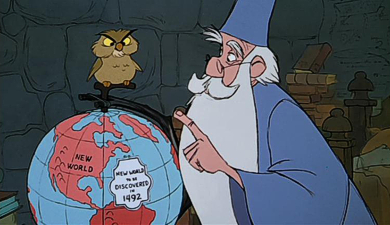
The film is easily one of Disney’s better framed for a widescreen ratio from this time, as confirmed by the clearly wide-safe main titles…and from the initial menu opening it looks like we’re in for a very decent, secondary-level Studio clean-up that suited The Rescuers perfectly. HOWEVER, be aware that someone seems to have hit the DVNR button – usually a Disney no-no – after an initial HD transfer. Although it may sport a simpler look due to its stylized background art and other anomalies could also be down to the production process of the time, the movie just doesn’t look pin-sharp enough to warrant a recommendation. Colors seem to be accurate, but the knockabout nature and rough style of the film itself is dumbed way down, with many scenes smudgy and waxy in appearance. I won’t say it’s Gulliver’s Travels-bad, but it is awful for a Disney Studio release, and this is no way to celebrate any film’s 50th birthday.
Scratch Tracks:
The original collectors’ CAV LaserDisc of The Sword In The Stone introduced a then-“new” stereo mix that had actually been created at the time of the film’s original release in 1963 but had not been widely used. The LD track was fairly warm, with some depth to the sound and a few surround surprises thrown in, the two later DVDs claiming 5.1 remixes but otherwise clear of any discernible differences from the laser. A shift to DTS Master Audio doesn’t have the effect it might have here, and I wonder if it’s the same track, just less compressed. However, everything is present and correct and the audio effects do have quite a nice spatial separation in them. Dialogue was recorded cleanly and makes for good reproduction here, as with the French and Spanish surround tracks also offered. In addition, subtitles in a choice of languages can also be selected.
Final Cut:
Opening on Christmas Day 1963, The Sword In The Stone may not rate as highly on many critics’ lists as some of Walt’s greater achievements, but remains an entertaining curiosity for fans and newcomers alike, falling well into the tradition of the recent comedy Disney features such as Aladdin and The Emperor’s New Groove. It’s never been seen as one of Disney’s best, but The Sword In The Stone is in fact a very enjoyable picture, and although none of the characters went on to much success outside of the film – Merlin is perhaps the most well-known figure in the movie, with his nose apparently based on Walt’s own! – it did inspire an on/off Sword Ceremony attraction at Disneyland.
This Blu-ray HD (if it even is true HD, as some have questioned) update is an odd one from the Studio: on one hand the addition of a new extra is most welcome, but it’s such a shame that the full Walt-hosted television program is missing, meaning that fans will need to hold onto their Gold Collection editions for some extra Walt magic. Even worse is the picture “restoration”, which seems to have occurred and then had an unnecessary scraping of grain removal applied, resulting in an unfortunately smeary DVNR image unusual for releases from a Disney that should be ashamed – and this on a release priced up from the usual $30 catalog title cost to over $35!
At this point, you’re either committed to collecting all of the Studio’s animated movies on Blu-ray or not, but even so it’s difficult to recommend The Sword In The Stone based on the extremely questionable image quality. The Studio has tried to provide a cleaned-up version on the cheap, pure and simple, and it’s a decision that may come back to haunt them: word of mouth should result in poor sales that the Studio will likely put down to the title not being popular enough. It’s not that, it’s the simply awful digital scrubbing that has been applied: the best thing Disney can do is cut it’s losses and issue a more suitable replacement immediately.
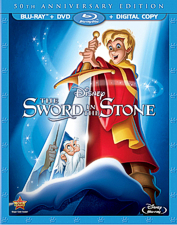 | ||
 |


